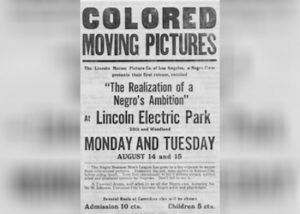
*Black history in American cinema is celebrated on this date in 1898. These are films made by, for, or about Black Americans.
Historically, African American films have been made with African American casts and marketed to African American audiences. The short movie Something Good – Negro Kiss was created in 1898. Early commercial films often depicted minstrel shows until vaudeville acts overtook them in popularity. An African American appeared in the narrative film as early as 1909. Also, that year, Siegmund Lubin produced the comedy series, using a Black cast, with the derogatory title Sambo. Before then, film roles for Black actors were played by white actors in blackface.
Sam Lucas became the first Black actor to be cast in a leading role in a mainstream film, appearing in the 1914 film Uncle Tom's Cabin. The Peter P. Jones Film Company in Chicago filmed vaudeville acts, the 1915 National Half-Century Exposition, and the Lincoln Jubilee. William D. Foster's The Foster Photoplay Company in Chicago was one of the earliest studios to feature African Americans. Casts for its films included performers from stage shows at the Pekin Theatre. The Lafayette Players and The Ethiopian Art Theatre also had several players who crossed into filmmaking. REOL Productions was a New York City studio that produced films in the early 1920s. During its relatively short existence, REOL had a couple of documentaries, comedies, and feature films.
Lincoln Motion Picture Company was established in Omaha, Nebraska, before relocating to Los Angeles and was among the first Black producers of Black film. The short-lived white-owned Ebony Film Corporation was founded in 1915. The white ownership's poor judgment about its stereotype-laden films aimed at white and Black audiences led to a public outcry from Black audiences in the wake of divisive anger about The Birth of a Nation. As a result, the company shut its doors in 1919.
Black women made their mark; social activist Maria P. Williams produced, directed, and starred in a 1923 melodrama, The Flames of Wrath. Given the undifferentiated roles, the director is typically granted to Tressie Souders, who directed 1922's A Woman's Error. Norman Studios, founded in 1920 in Jacksonville, Florida, produced drama films with African American casts, even though Norman was white. Between 1920 and 1928, however, he made a string of successful films starring Black actors. Biograph Films produced a series of comedy shorts with comedian Bert Williams.
Often, the production team and director were also black. More recently, Black films featuring multicultural casts aimed at multicultural audiences have also included American Blackness as an essential aspect of the storyline. Segregation, discrimination, issues of representation, derogatory stereotypes, and worn-out images have dogged Black American cinema from the start of the 20th century-plus history that roughly coincided with the century-plus history of American cinema. From the earliest days of moving pictures, major studios used Black actors to appeal to Black audiences. They also relegated them to bit parts, casting women as maids or nannies and men as natives or servants or either gender as a "magical negro," an update on the "noble savage."

Black filmmakers, producers, critics, and others have resisted narrow models and offensive symbols in many ways. As early as 1909, Lester A. Walton, the art critic for the New York Age, was making sophisticated arguments against the objectification of Black bodies onscreen, pointing out that "anti-Negro propaganda strikes at the very roots of the fundamental principles of democracy." Noting the educational impact film could have, he argued that it could be used to "emancipate the white American from his peculiar ideas," which were "hurtful to both races." The "race films" of 1915 to the mid-1950s followed a similar spirit of "racial uplift" and educational "counter-programing" to combat the racism of the Jim Crow South.
That sensibility shifted in the 1960s and 70s. Although Blaxploitation films continued to include stereotypical characters, they were also praised for portraying Black people as the heroes and subjects of their stories. By the 1980s, auteurs like Spike Lee and John Singleton created nuanced depictions of Black lives, which led the way for later filmmakers like Jordan Peele and Ava DuVernay to use a range of genres (horror, history, documentary, fantasy) to explore Black lives from multiple perspectives.
The 2018 superhero film Black Panther has also been widely praised for creating a fully realized Afrocentric urban utopia of Black people, including a foundation myth, legendary hero, and delight in its African-ness. In 2021, Tyler Perry was awarded the Jean Hersholt Humanitarian Award.
Since the inception of the Academy Awards in 1929, only 22 Black actors have won Oscars.
To Become an Animator
To Become a Media Producer or Director